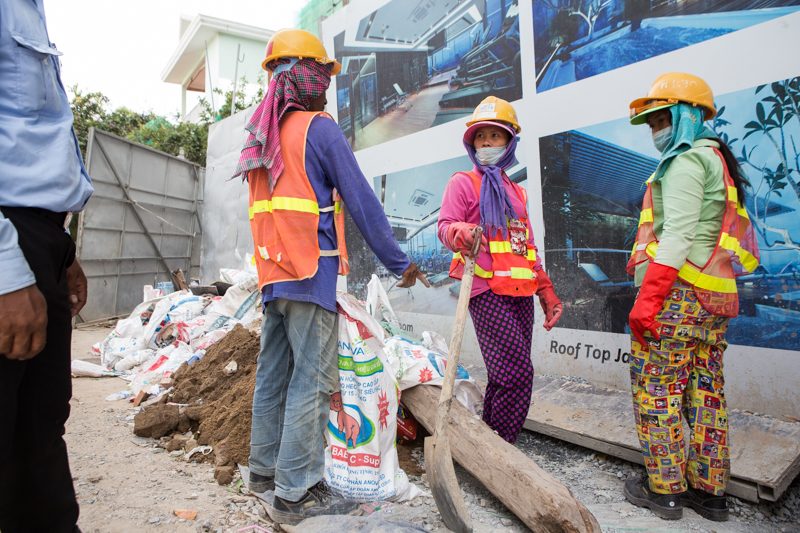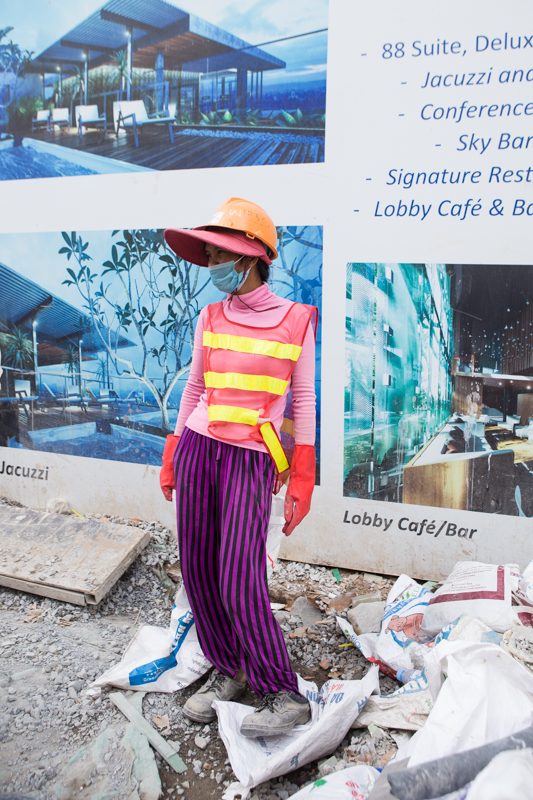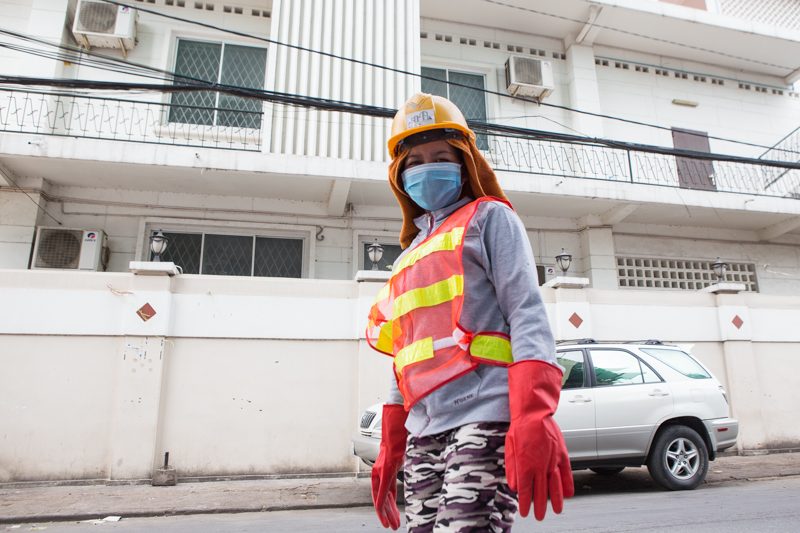At a bustling construction site in the heart of Phnom Penh, the women stand apart, separated from their male co-workers by more than just their brightly-colored, mismatched clothes that jump out against the concrete-gray surroundings.
As they shovel sand and rocks into bags, men wield power tools. As they sweep the job site, men paint walls, set plumbing pipes and wind electrical wires through the luxury apartment project that’s climbing above the trees on the corner of streets 228 and 55 in Daun Penh district.

The women, decked out in matching yellow safety vests and hardhats, prepare building materials for men, take orders from men and are paid by men.
In a rapidly expanding industry that has become a bedrock of Cambodia’s economy, female construction workers make up 30 percent of the workforce. But, across the board, they are less skilled, lower paid and given little chance to change their situation.
Thong Ngern, 32, who grew up in Kampot, earns 20,000 riel, or about $5, per day—more if she has to work late. For each hour after 7 p.m., she earns another 3,000 riel, about $0.75. At the end of a week of hard labor, perhaps she’ll take home $30.
It’s not enough. The wage is “only enough for living expenses,” she said. “I don’t have any savings.”
She can’t read and she has no idea what she agreed to when she signed an employment contract with Sambo Construction & Development Co. The woman shoveling sand beside her, 48-year-old Heng Chamreoun, said she did not even receive a contract.
They are resigned to their place in the building site’s hierarchy, always a step behind, or in the shadow, of men.
“What can we do? We don’t have skills like them,” Ms. Ngern said, leaning on a fence emblazoned with ads for the building’s sky bar and rooftop Jacuzzi. “It’s just the way it is.”

Shared Plight
Research released on Friday by CARE Cambodia, a global anti-poverty NGO with a focus on women’s issues, shows the situation at the Phnom Penh worksite is common in a country where women have fewer opportunities, less training and less education than men.
In the report, “Women in Cambodia’s Construction Industry: Their Work, Their Knowledge, Their Safety,” researchers noted that even when men and women perform the same work on a job, pay disparities persist.
Ninety percent of the women they surveyed reported earning $1 to $3 less per day than men “for work of the same value”; 92 percent said they received no written information about their employment terms at their hiring; and about half said they had not received any information about the job at all.
And, similar to the experience of the two workers at the Phnom Penh apartment complex, the report found 73 percent of women performed two or three of the lowest-skilled tasks on job sites, such as “carrying, preparing and handing construction materials” to their male co-workers.
CARE work adviser Adriana Siddle attributed the pay gap to a lack of opportunities for women, who are typically deprived of training that would enable them to do work that is more highly valued, and therefore more highly paid.

“Women are low-skilled and not performing the same type of work as men. They’re cleaning or doing detail work; work which is not valued the same as manual labor,” she said.
Gender pay gaps are seen in many fields around the world, but they are particularly obvious in the construction industry, and the effects go deeper than paychecks, Ms. Siddle said. Women internalize the disparity and “see themselves as lesser than men,” she said.
Rath Kalyan, a CARE project manager for labor rights, said the issue was a reflection of entrenched mindsets. “If we look into the Cambodian context, women are being given this type of job based on their gender,” she said. “They accept it because they think they’re weaker than men, so this kind of job fits into their idea of a woman’s role—it’s gender stereotypes.”
To help bridge the gender divide, CARE is holding free monthly training sessions for construction company managers and supervisors. Companies receive certificates for completing the one-day seminars, which focus on encouraging employers to give equal opportunities to their female workers.
At the first session last month, about 15 representatives from seven different construction companies, a majority of them Cambodian-owned, learned about the challenges women face when working under unequal conditions.
Through two local partners—Cambodian Women for Peace and Development, and the Building and Wood Workers Trade Union Federation—CARE is also planning workshops for female workers. Topics will cover gender and women’s empowerment, health and safety, managing money and employment rights, of which few women in construction have an understanding, according to CARE’s research.

“None of the women surveyed understood the concept of paid leave,” Ms. Siddle said. “They don’t know that they have protections.”
The group running the project’s legal aspects, Legal Services for Children and Women, will also provide female workers with free guidance should they need to pursue compensation, unpaid wages or other claims.
The initiative is welcomed by Thida Khus, the head of women’s rights and training organization Silaka, who said outdated attitudes about what women are capable of are widespread in the construction industry.
“We know that there is a big pay gap between women and men doing the same job, but if you’re talking about women in the construction companies, there is an even wider gap, because they don’t expect women to do physical jobs, like heavy lifting, painting walls or laying down tiles,” Ms. Khus said. “Women can do these things, but they pass it on to men.”
Women in the industry are also limited by traditional societal expectations of “ladylike” behavior, which conflicts with tasks such as climbing ladders, she said.
“In reality, society should get over this.”
Climbing the Ladder
Despite stubborn gender stereotypes, advocates are optimistic that research and training will help break down barriers and encourage women to see that they can perform more valued work and earn bigger paychecks.
They also realize that not every woman will be eager to take up the opportunity to do traditional “men’s work.”
Sy Met, 49, moved to the capital from Prey Veng province to work on an apartment building on Streets 222 and 55 with her husband. He earns 5,000 riel, or about $1.25, a day more than her, and she is quite happy with things as they are.
“I don’t really care if that is for men or that is for women,” Ms. Met said. “Our work is not the same—their labor is more intense—but I don’t feel like something is wrong that way.”
Ms. Chamreoun, from the site on Street 228, shared her sentiments. “I have never thought of doing the men’s job because it is just not for me,” she said.
For some women, a change in thinking “might take some coaching,” Ms. Khus said.

Oum Pivorn, adminstration manager for Cambodia Constructors Association, which focuses on investment and technical support in the industry, said they provide free training to their members for skilled construction work such as steel joining, pile working and electrical wiring, but most companies did not send their female employees.
“There have been around 200 to 300 workers trained so far, and most were male. Very few companies have sent their female workers to receive training,” said Mr. Pivorn. “The proportion is about 2 out of 100.”
Mr. Pivorn said there should be a more equitable distribution of work on construction sites—although he still said potentially dangerous tasks, such as working on the open upper floors of a high rise, should be left to men.
“I think women should receive the same payment as men in the construction field,” he said. But, he added, “we should give them reasonable tasks.”
For 47-year-old Seoun Pheap, who works and lives at a construction site on the corner of streets 51 and 262, the opportunity to learn new skills and make more money would be a welcome change.
A former seasonal farmer from Prey Veng province, she earns 22,000 riel, or about $5.50, a day carrying bags of sand or metal poles to her male co-workers, who earn 32,000 riel, or about $8.
“How can we be equal? It is not equal,” she said, her dirty pajamas blending into the rusted poles gathered in her hands.
“But if someone teaches me the skills, I will definitely learn as long as I can make more money.”




